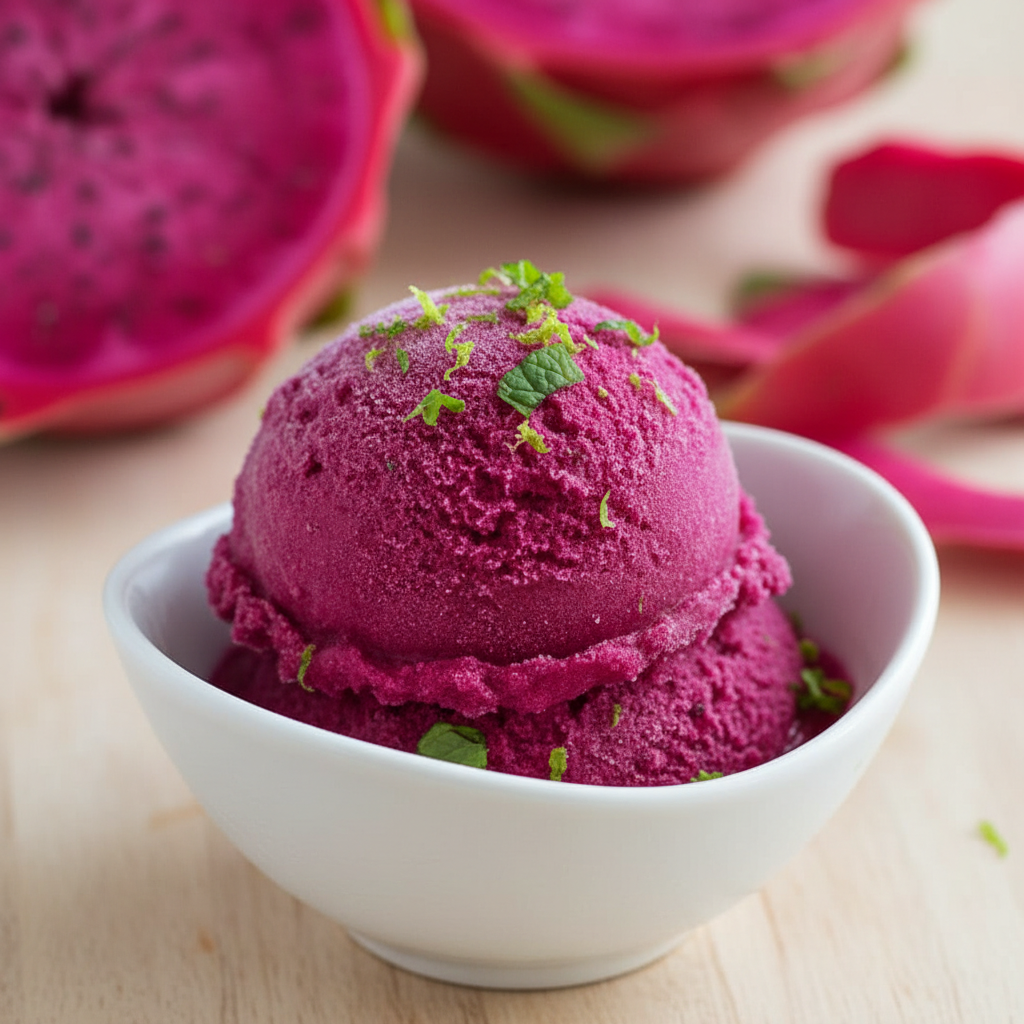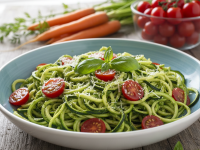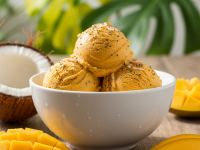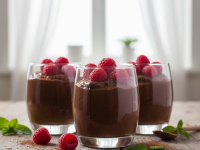Hey there, fellow food adventurers! If you’re anything like me, you probably love the vibrant, exotic beauty of a pitaya, or dragon fruit. That stuing pink or yellow exterior, the speckled white or red flesh inside – it’s a feast for the eyes and the palate. But let me ask you something: what do you usually do with the peel once you’ve scooped out that delicious fruit?
If your answer is “throw it away,” then you’re about to have your mind blown. For years, I did the same. I’d admire the gorgeous hue of the peel for a moment before it found its way to the compost bin (or worse, the trash). It felt almost sacrilegious to discard something so beautiful, but what else could I do with it? Then, one sweltering afternoon, a moment of inspired frustration (and a desire to be more sustainable in my kitchen) led me down a path I never expected: turning those discarded pitaya peels into the most incredibly refreshing, shockingly delicious sorbet.
Yes, you read that right. Pitaya peel sorbet. And trust me when I say, this isn’t just some experimental, “it’s okay” kind of treat. This is a legitimate, crave-worthy dessert that boasts an unbelievable color, a subtly sweet flavor, and the ultimate bragging rights of being a truly zero-waste culinary masterpiece. So, grab your pitaya, because we’re about to transform what you thought was trash into pure, frozen treasure!
Why Pitaya Peels? The Unsung Hero of Your Fruit Bowl
Before we dive into the delicious details, let’s talk about *why* we should even consider eating pitaya peels. Beyond the obvious joy of reducing food waste, these seemingly insignificant skins are actually packed with goodness. Think about it: nature doesn’t create waste. Often, the “outer layers” of fruits and vegetables are incredibly nutrient-dense.
- Nutrient Powerhouse: Pitaya peels are rich in antioxidants, particularly betacyanins (which give them their striking red/pink color), fiber, and various vitamins and minerals. These compounds are fantastic for your health, supporting everything from gut health to fighting oxidative stress.
- Vibrant Color: This is perhaps the most immediate benefit you’ll notice. The intensity of the peel’s pigment translates directly into a naturally stuing sorbet. No artificial colors needed here!
- Subtle Flavor: Unlike some fruit peels that can be bitter or tough, pitaya peels, when properly prepared, have a very mild, slightly earthy, and subtly sweet flavor that complements the fruit itself beautifully. It doesn’t overpower; it enhances.
- Zero-Waste Satisfaction: There’s a deep satisfaction that comes from knowing you’ve utilized every part of a fruit. It’s a small step towards a more sustainable kitchen, and it feels incredibly good.
So, we’re not just making sorbet; we’re unlocking hiddeutrients and colors while being kind to our planet. How cool is that?
My Journey from Waste to Wonder: A Culinary Experiment
My journey to pitaya peel sorbet started, as many good recipes do, with a bit of a challenge. I had just finished enjoying a beautiful red pitaya, and as I held the emptied peel, I couldn’t bring myself to toss it. It was so vibrant, so perfect! I remembered reading about people using citrus peels for zest or making candied peels, and a thought sparked: could pitaya peels be edible?
A quick search revealed that, yes, they are! However, most recipes suggested teas or tinctures – nothing quite as exciting as a dessert. My mind immediately went to the texture. The peel is somewhat firm but not overly tough. If I could blend it smooth enough, perhaps… a sorbet? I was skeptical, I’ll admit. Would it be bitter? Too fibrous? Would it even taste good?
My first attempt involved simply blending the cleaned peels with a bit of water and sugar. It was… okay. A little too icy, a little too bland. But the *color*! Oh, the color was magnificent. This told me I was onto something. I needed more flavor, a smoother texture, and a better freezing technique. I experimented with adding a squeeze of lime, a touch more sweetener, and crucially, incorporating some of the actual pitaya flesh for a boost of fruitiness and natural sugars. I also learned the hard way that a high-powered blender is your best friend here, and periodic churning during freezing is non-negotiable for that perfect, scoopable consistency.
After a few tries, the magic finally happened. The sorbet was perfectly smooth, intensely colorful, and had a delicate, refreshing flavor that was a revelation. My family, initially wary of “peel sorbet,” was absolutely stued. It quickly became a summer staple, a conversation starter, and my proudest zero-waste creation.
Gathering Your Treasure: What You’ll Need
Ready to embark on your own pitaya peel sorbet adventure? Here’s what you’ll need:
Ingredients:
- Peels from 2-3 medium-sized red/pink pitayas (dragon fruits) – make sure they’re fresh and blemish-free!
- 1/2 cup fresh pitaya flesh (from the same fruits, or a separate one)
- 1/4 cup granulated sugar (or to taste; adjust based on the sweetness of your fruit and preference)
- 1/4 cup water (or coconut water for extra flavor)
- 1-2 tablespoons fresh lime juice (this is key for brightness and cutting any potential earthiness)
- Optional: A pinch of salt (enhances sweetness), a tiny piece of ginger for zing, or a few mint leaves for freshness.
Equipment:
- High-powered blender (absolutely essential for a smooth texture)
- Fine-mesh sieve (optional, but recommended for ultra-smoothness)
- Airtight freezer-safe container (preferably shallow for quicker freezing)
- Spatula or spoon for stirring/churning
The Magic Unfolds: Step-by-Step Recipe
Alright, let’s get those peels ready for their starring role!
Step 1: Clean Your Peels Meticulously
This is crucial! The outer skin of pitayas can harbor dirt or residues. Thoroughly wash the peels under cold ruing water. You can even use a soft brush to gently scrub them. Once clean, pat them dry with a clean towel. Trim off any hard, tough bits at the very ends or any bruised spots. You want the vibrant, flexible parts of the peel.
Step 2: Chop and Prepare for Blending
Cut the clean pitaya peels into small, roughly 1-inch pieces. The smaller the pieces, the easier your blender will work. Place these pieces into your high-powered blender.
Step 3: Blend with the Essentials
Add the 1/2 cup of fresh pitaya flesh, 1/4 cup of sugar, 1/4 cup of water (or coconut water), and 1 tablespoon of lime juice to the blender with the peels. If you’re using optional ginger or mint, add them now too.
Blend on high speed until the mixture is incredibly smooth. This might take a few minutes, and you might need to stop and scrape down the sides of the blender a few times. The goal is no discernible chunks of peel. If the mixture is too thick to blend, add another tablespoon or two of water, but be mindful not to add too much liquid, as it can make the sorbet more icy.
Step 4: Strain for Ultimate Smoothness (Optional but Recommended)
For a truly silky-smooth sorbet, press the blended mixture through a fine-mesh sieve into a bowl. Use a spatula to help push the liquid through, leaving behind any tiny, fibrous bits of peel that the blender might have missed. This step makes a noticeable difference in texture, elevating your sorbet from homemade to gourmet. Taste the mixture and adjust sweetness or lime juice if needed.
Step 5: Freeze and Churn
Pour the smooth pitaya mixture into your shallow, freezer-safe container. Cover it and place it in the freezer. Now, here’s the secret to that perfectly scoopable, not-too-icy texture: churning.
- After about 1-2 hours, when the edges start to freeze, take the container out.
- Using a fork or a sturdy spoon, vigorously scrape and stir the frozen edges into the softer center. Break up any ice crystals.
- Return to the freezer and repeat this process every 30-60 minutes for the next 2-3 hours, or until the sorbet is mostly frozen but still pliable. The more you churn, the creamier your sorbet will be.
Step 6: Final Freeze and Serve
Once the sorbet has reached a thick, slushy consistency from churning, smooth the top, cover it, and let it freeze for at least another 2-4 hours (or overnight) to firm up completely. When you’re ready to serve, let it sit at room temperature for 5-10 minutes to soften slightly, making it easier to scoop. Serve in chilled bowls or glasses, perhaps garnished with a fresh mint leaf or a slice of lime. Prepare for gasps of delight!
Tips for Sorbet Success (and Avoiding Pitfalls!)
Based on my own kitchen adventures, here are a few pointers to ensure your pitaya peel sorbet is a smashing success:
- Don’t Skimp on Blending: This is the most critical step. A high-powered blender is key. If you don’t have one, consider finely dicing the peels before blending and definitely strain the mixture.
- Taste and Adjust: Pitayas vary in sweetness. Always taste your mixture before freezing and adjust the sugar and lime juice to your preference. The flavors will be slightly muted when frozen, so make it a little bolder than you think you need.
- The Power of Lime: That squeeze of fresh lime juice isn’t just for flavor; it helps cut through any potential earthiness from the peel and brightens the entire sorbet, making it incredibly refreshing.
- Don’t Overdo the Liquid: Too much water will result in an icy, hard sorbet. Start with the recommended amount and only add more if your blender is truly struggling.
- Embrace the Churn: Seriously, don’t skip the churning! This is what prevents large ice crystals from forming, giving you that smooth, creamy sorbet texture you crave. If you have an ice cream maker, you can use it for the final chilling stage after blending and straining.
- Freshness is Key: Use fresh, unblemished pitaya peels for the best flavor and safety.
Beyond Sorbet: Other Peel Potentials
If you’re now convinced of the power of the pitaya peel, know that sorbet is just the begiing! You can also dry the peels and grind them into a powder for natural food coloring, steep them in hot water for a vibrant and antioxidant-rich tea, or even add small, finely diced pieces to smoothies. The possibilities are surprisingly vast!
The Sweet Reward of Zero Waste
There you have it – my tried-and-true recipe for a truly spectacular pitaya peel sorbet. It’s a testament to the idea that sometimes, the most overlooked parts of our food can hold the greatest treasures. This recipe isn’t just about making a delicious dessert; it’s about shifting our perspective, embracing sustainability, and finding joy in creativity in the kitchen.
So, the next time you enjoy a pitaya, don’t let those beautiful peels go to waste. Give this recipe a try, and prepare to impress yourself and everyone around you with a vibrant, refreshing, and utterly unique treat. Happy scooping, and happy zero-wasting!




